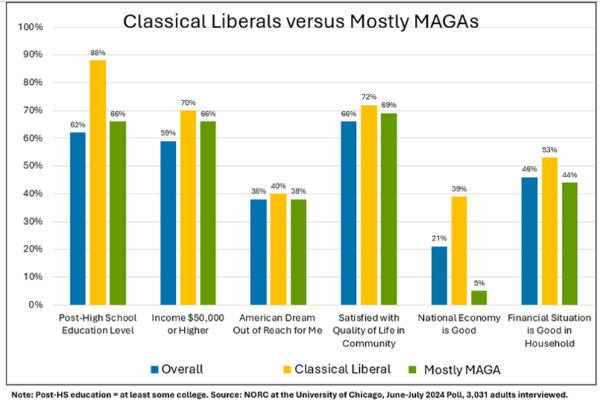Typologies reveal patterns by organizing data based on shared characteristics. This process simplifies complex information to highlight meaningful similarities and differences within and across various categories. Typologies are useful tools for analysis and problem-solving, but they don’t capture the full reality of anything or exhaust the possibilities of understanding. In other words, typologies reveal some truths and obscure others.
Grouping people by types also runs the risk of seeing individuals as static, unchanging essences. People and patterns change. Within-group affinities and between-group differences may weaken over time, eventually rendering a whole typology obsolete. But the typologies keep coming, partly because humans love to categorize and partly because new typologies unsettle our certainties and assumptions and help us see the world with fresh eyes.
With that in mind, I introduce the Five Types of Americans, as developed by the National Opinion Research Center (NORC) at the University of Chicago. Per NORC:
“Most discussions of people’s civic attitudes are typically viewed through a prism of political ideology, age, or demographics, such as race and education. We wanted to understand these attitudes based on more nuanced factors – such as trust in democratic processes and political institutions, connections to community and faith in their fellow Americans, as well as people’s outlook on America’s future.
What we found is that the nation can be more clearly understood as five different groups, which do not divide neatly along party or ideological lines.” - Civic Cynicism in the United States: A Typology of Americans.” Final Report, NORC at the University of Chicago, November 2024.
A brief overview of the types:
The two types I’m most interested in are the Classical Liberals and Mostly MAGAs. Some comparisons:
Keep in mind the survey that inspired this typology was conducted in 2024, when Biden was president. At the time, consumer sentiment surveys consistently found Democrats to be more satisfied with the economy than Republicans. The tables have turned now that Trump is in charge: according to the September 2025 Consumer Sentiment Index, Republicans are much happier with the state of the economy than are Democrats.
More than 80% of Classical Liberals are Democrats and over 80% of Mostly MAGAs are Republicans, so I suspect their widely divergent opinions about the national economy in 2024 stemmed in large part from political bias.
More on the political breakdown of these types in the next post.
Reference:
Civic Cynicism in the United States: A Typology of Americans. Final Report, November 2024. Presented by: NORC at the University of Chicago. Presented to: Louisiana State University Manship School of Mass Communication. https://www.norc.org/content/dam/norc-org/pdf2024/lsu-report.pdf

